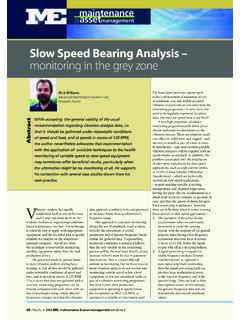Transcription of Applying PMBOK to Shutdowns, Turnarounds and …
1 Maintenance & asset management vol 20 no 319 Turnarounds have a distinctive character of their own and cannot be managed as if they were just another sort of Engineering, Procurement and Construction (EPC) project; a turnaround-specific methodology of management is needed. Drawing on the philosophy of the Project Management Institute s Guide to the Project Management Body of Knowledge ( PMBOK ) the author reviews the special problems presented by process plant Turnarounds and also their particular management PMBOK to Shutdowns, Turnarounds and Outages Bernard Ertl Vice President, InterPlan Systems TURNAROUND-SPECIFIC MANAGEMENT METHODOLOGYThe discipline of project management enjoys different states of maturity across different industries, the construction industry probably enjoying the greatest maturity in this field while the software development/IT industry is probably enjoying the greatest growth in maturity at this time. In the process industries the maturity of the project management discipline as regards Turnarounds is still very poor, stagnant at appears to be little if any development of, or dialogue about, the discipline within the field.
2 Turnaround failures (budgets blown by millions of dollars, target dates missed by days) are still as prevalent as ever. The same mistakes are being repeated over and over. The main problem is that turnaround managers continue to treat Turnarounds as if they were Engineering, Procurement and Construction (EPC) civil projects and hence apply an EPC-centric project management of the greatest challenges to turnaround managers is realising that Turnarounds are different from EPC projects. They have their own unique characteristics and demands. They require a specialised project management methodology . This document is intended to spark a dialogue for developing a turnaround-specific management Project Management Institute (PMI) has published A Guide to the Project Management Body of Knowledge ( PMBOK ) which identifies and describes the subset of the project management discipline that is applicable to most projects most of the time. It FOREWORDS hutdowns, Turnarounds and outagesAll the major process industries (refining, petrochemicals, power generation, pulp and paper, etc.)
3 Have their own nomenclature for maintenance projects. For the purposes of this document, turnaround is intended to encompass all types of industrial projects for existing process plants including Inspection and testing Shutdowns Emergency outages De-bottlenecking projects Revamps Catalyst regeneration, all those instances when an operating plant must be shut down until the work is completed and then restarted, thus turning around the unit or plant. In this paper turnaround is also intended to refer to the entire span from pre-turnaround preparations, to shutdown, to execution and finally to & asset management vol 20 no 3 20provides a loose guideline for structuring a project management methodology , and describes its primary purpose as being ..to identify and describe that subset of the PMBOK that is generally accepted. Generally accepted means that the knowledge and practices described are applicable to most projects most of the time, and that there is widespread consensus about their value and usefulness.
4 Generally accepted does not mean that the knowledge and practices described are or should be applied uniformly on all projects; the project management team is always responsible for determining what is appropriate for any given project. It is up to turnaround managers to evaluate the applicability to Turnarounds of their specific project management methodology . Many turnaround managers do not have a formal background in project management and have never studied the PMBOK . As a result, there has been little discussion in professional circles of the proper application of the PMBOK to a turnaround-specific management turnaround managers employ an EPC-centric project management approach to Turnarounds . In order to analyse the applicability of this approach, we first need to understand the important differences between Turnarounds and EPC projects. Then we shall have the proper basis for evaluating a turnaround-centric project management methodology in accordance with the differences between Turnarounds and EPC projectsThere are significant differences between Turnarounds and EPC projects (see Table 1), which are worth the scope is only partially known when execution begins, Turnarounds demand much stricter scope management controls.
5 A constantly changing scope (and schedule) means that the baseline schedule is a useless measuring stick. As it is the entire basis for measuring and tracking EPC project performance, it is clear that a different paradigm is required for changing schedule and changing manpower requirements make resource levelling, a popular tool for EPC projects, counter-productive for Turnarounds . This issue is explored in greater depth in the Resource Levelling Vs. Critical Mass white paper which can be found on our website ( ).The compressed work basis for executing Turnarounds means that all team members have less time to analyse and react to changing priorities. Problems that go unchecked can significantly affect the likelihood of reaching time and budget goals. As a consequence, there is a much greater need to use the schedule to drive the project execution (whereas it is sometimes used mostly as a contractual tool in EPC projects). It is critical for all schedule and progress information to be highly visible, timely, comprehensive and these distinctions in mind, we can now explore the tenets of the PMBOK and start working towards a turnaround-specific project management PMBOK to Shutdowns, Turnarounds and OutagesTable 1.
6 EPC projects vs. turnarounds1. Usually well-defined scope, from: a. drawings b. specifications c. contracts d. permits, memos, Scope is static. Few changes occur during Can be planned and scheduled well in advance of the Projects are organized around cost codes / Generally do not require safety permits to perform Manpower staffing requirements usually do not Project schedules can be updated either weekly or Projects measure time in days, weeks and Project scope is usually all Project schedules are uncompressed. Schedule acceleration can be used to correct slippages in the critical Usually loosley defined scope, from: a. past turnaround experience b. inspection reports c. operations requests d. historical estimates2. Scope is dynamic. Many changes occur as inspections are Planning and scheduling cannot be finalized until the scope is approved, generally near the shutdown Turnarounds are work order Turnaround work requires extensive permitting every Manpower staffing requirements change during execution due to scope Turnaround schedules must be updated every shift, Turnarounds measure time in hours or Turnaround scope is flexible.
7 Usually a large percentage of work can be postponed to a later window of opportunity if Turnaround schedules are compressed. There may be little or no opportunity to correct the critical path by accelerating the & asset management vol 20 no 321approved budget or authorisation for expenditure (AFE). If not, either the scope should be culled where possible (or failure to meet the budget will be pre-determined) or the budget should be adjusted to reflect the plan (not always politically viable).Scope change controlIn a turnaround, the scope will change - sometimes dramatically. As equipment is opened, cleaned and inspected the extent of required repairs can be determined, planned, costed and either approved or tabled for a future window of opportunity. Every add-on to the schedule should be processed with a defined procedure for additional challenge is presented in companies where the existing culture allows operators to direct work crews (or get supervisors to direct work crews) to perform work that for one reason or another was not included in the approved project scope.
8 The only solution is to change the culture to respect the defined procedure for add-on approval. Operators and supervisors or superintendents must buy in to the add-on approval procedure and field hands must be directed to work only on approved scope as directed by their supervisors. Where this is not possible (or there is a work in progress ) it is imperative to at least document and account for these unapproved jobs, where performed, so that progress tracking (earned value) may give a meaningful impression of the productivity of the field needs to exercise care when evaluating add-on repair scope, in order to ensure that existing resources, productivity and time can accommodate the work (where the repair scope is not operationally critical or safety critical). Management can end up in a position of balancing the impact of add-on repair work against the culling of original scope where resources become constrained on work that is non-PROJECT SCOPE MANAGEMENTOne of the greatest challenges in a turnaround is scope management.
9 This is true for virtually all phases of scope management as outlined by the PMBOK , viz. Scope Planning, Scope Definition, Scope Verification and Scope Change planning, definition and verificationUnlike EPC projects which usually have a well defined scope established with long lead times before the project execution phase it is common for turnaround scopes to be changing up to the last minute before project execution. There are several factors contributing to this Market conditions (plant profitability) can cause variability in considerations for the budget (requiring scope adjustments), window (squeezing or relaxing the time frame available for executing the project) and start date (which may affect the decisions on what scope to include, the ability to plan the work, or material availability). Planning input is usually derived with input from Operations, Inspection, Safety, etc., and Operations may continue to identify potential scope for the turnaround until the last minute.
10 The availability of specialised tools, materials, equipment and/or resources may affect decisions on how to approach portions of the scope ( plans may need adjusting to accommodate a different method or scenario to accomplish the same goal).One result of this is that turnaround budgets are rarely based upon a complete, detailed plan. They are often based upon conceptual estimates, extrapolations of past Turnarounds , or on incomplete planned scopes that are compensated with a large allowance for contingencies, and it is therefore necessary to review the cost estimate for the final approved scope and make sure it is covered by the Operators and supervisors or superintendents must buy in to the add-on approval procedure and field hands must be directed to work only on approved scope as directed by their PMBOK to Shutdowns, Turnarounds and Outagesmaintenance & asset management vol 20 no 3 22critical (from both a time and operational or safety point of view).It is desirable to classify scheduled or progressed activities according to two main criteria, viz.







